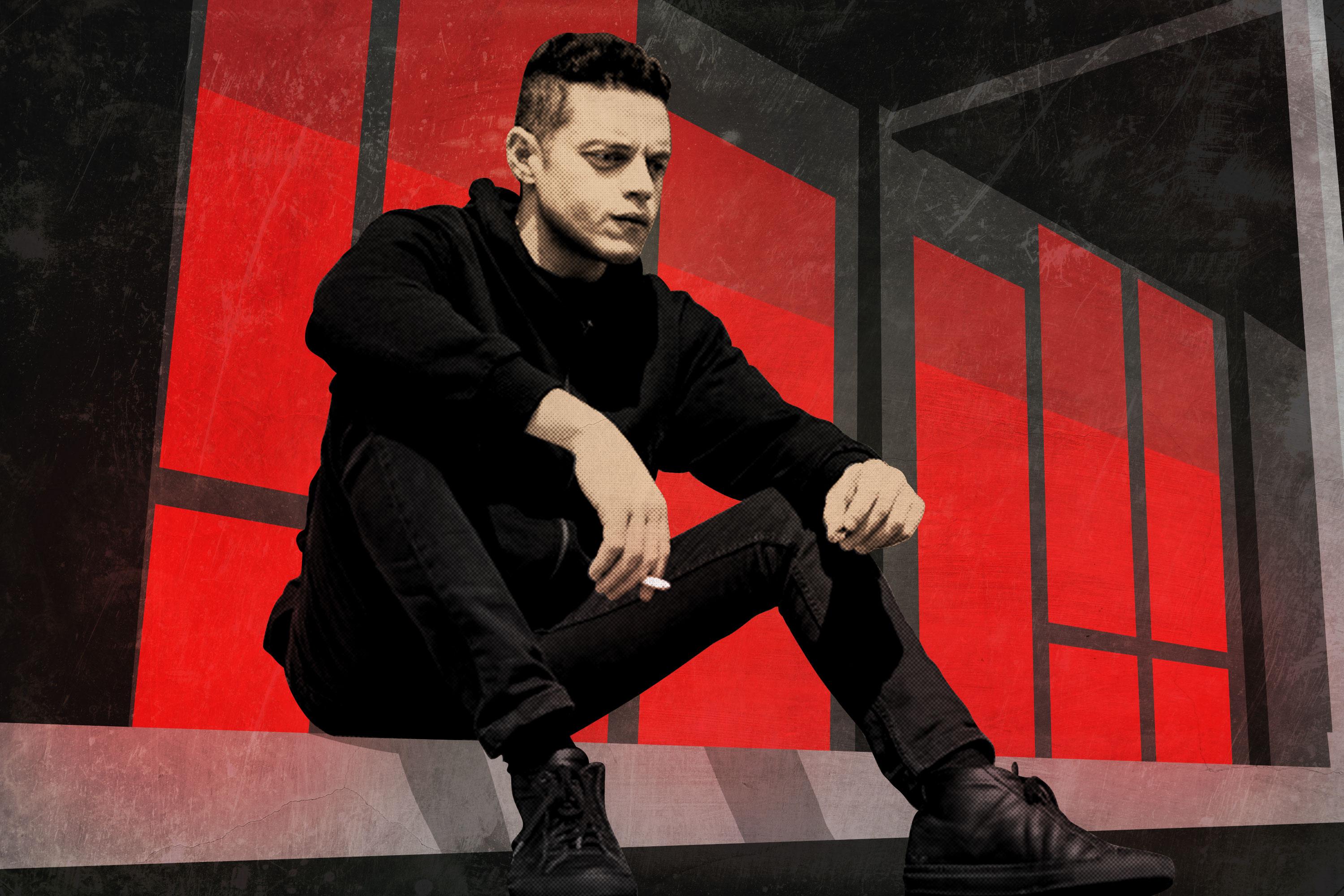

Elliot Alderson, the hacker protagonist of Mr. Robot, has always had a flair for melodrama. His self-serious, anticapitalist screeds—they’ve been around since the pilot—can sound ridiculous even if they are well-intentioned. Elliot’s hacker group, the unsubtly named fsociety, would put on Guy Fawkes–esque masks when dropping videos online; meanwhile, he’s always wearing the same black hoodie. It could feel a little cheesy, especially when he repeatedly spoke to the audience—referring to us as a collective “friend.” If there is a criticism that can be lobbed at Mr. Robot, aside from pointing out its occasional overreliance on twists, it’s that Elliot’s convictions can sometimes make him feel like a caricature of himself. (And that’s before we get to his alternate personality, Mr. Robot, an anarchist who appears in the image of Elliot’s dead father.) But it turns out the character’s grandiose behavior and “I have the Fight Club poster in my dorm room” ideology was a point unto itself: This wasn’t the real Elliot, either.
Yes, Mr. Robot and its creator-writer-director, Sam Esmail, were saving one final twist for the two-part series finale, and it’s a doozy: The Elliot we’ve been following since the start of the show is yet another persona. The “real” Elliot has been hidden from view, protected—or seen another way, imprisoned—in an illusory world inside his own mind free of conflict, while Mr. Robot and the so-called Mastermind (a.k.a. our friend with a penchant for hoodies) go about making society a better place, from alerting the FBI about pedophiles to erasing billions in debt to hacking and redistributing the immense wealth accrued by the “top 1 percent of the top 1 percent.” Hoodie Elliot is kind of over-the-top because he represents an idealized version of the real Elliot that Elliot himself would fantasize about becoming: a vigilante hacker in the face of evil corporations; a superhero for the digital age.
This dream of fixing the world, and the reason other personas (which include two others in the form of his mom and a young Elliot) have manifested in real Elliot’s place, is something Mr. Robot had also slowly built toward in its final season—even if we didn’t fully understand the intent. In addition to the physical abuse inflicted on Elliot by his mother, which was established near the beginning of the show, we find out that as a kid Elliot was sexually abused by his father before the latter died from cancer. Elliot intentionally shielded himself from this trauma until earlier this season, when the drug dealer Vera forced Elliot’s therapist, Krista, to convince him to accept the awful truth. It’s among the most powerful, harrowing work Rami Malek’s done throughout the series.
Life has been unbearably cruel to Elliot, but after doggedly working to change Elliot’s world for the better the Mastermind is now unwilling to relinquish control. And so most of the finale sees the Mastermind reckon with his own identity within an identity within a fabricated world. The end of Mr. Robot is a surreal, deeply moving odyssey that’s more conceptually daring than the initial sci-fi trappings established going into the episode, where it appeared Elliot had actually stumbled onto a parallel universe created by the cyber-terrorist Whiterose. At one point in Elliot World, the series pulls a Being John Malkovich, and a Coney Island boardwalk is suddenly populated with men, women, and children, all with the face of Mr. Robot/Christian Slater—which I imagine (hope?) is the closest thing I’ll get to the experience of watching Tom Hooper’s Cats.
Lol, remember when this was a show about hacking? Mr. Robot has undeservedly lost a lot of fanfare since its Golden Globe–winning first season, which mostly played out like a cyber thriller, but its quiet evolution has yielded more twists (like the truth about Elliot’s father) and creative achievements (this season featured an episode that was almost entirely dialogue-free) in the service of its psychological subtext. The show’s plot might’ve taken shots at capitalism through some epic, hacking-centric setpieces, but Mr. Robot’s heart lay in its careful rumination on emotional trauma, processed pain, and how one reckons with their own sense of alienation.
This isn’t, if we’re being honest, what I was expecting when I first started the series. Superficially, I just thought Mr. Robot looked cool—despite its objectively silly-sounding title. As I suspect happened for a lot of initial viewers, I jumped onto the Mr. Robot bandwagon because of positive word of mouth and got sucked into its paranoiac sensibilities and distinct visual language, which included Esmail repeatedly “shortsighting” characters by putting them in extreme corners of the frame. (That effect somehow made the show feel even more paranoid and stress-inducing than it already was.) The world was a different place when Mr. Robot debuted in 2015: We were slightly less skeptical of big tech companies, and Barack Obama was still the president. The show, in retrospect, opened like a grim window into our immediate future, where pop culture has felt more attuned to modern anxieties centered on income inequality and class warfare—perhaps because we’re finally paying more attention to it. (Bernie, if you haven’t already, watch Mr. Robot!)
But while the scene late in the final season when Elliot’s sister, Darlene, redistributes the 1-percenters’ wealth with a literal push of a button is immensely satisfying, the quest to discover self-worth feels more pertinent to Mr. Robot and Esmail’s direction than dismantling the system. What’s the point in saving the world if you aren’t willing to be a part of it? The protagonists are all dealing with something: Darlene has her own anxiety that leaves her liable to panic attacks, and FBI agent Dom DiPierro becomes so removed from other people she considers an Alexa device her friend. Like Elliot, they come out of their own shells by the end of the series—emboldened not just by a world with fewer evil, rich assholes and without the systems that enabled them, but by learning to love themselves and the people around them.
It’s a beautiful, hopeful sentiment—encapsulated by the Mastermind finally accepting that his “job” is done so that the real Elliot can re-enter the real world in his and Mr. Robot’s place. Never one to cop a bland aesthetic, Esmail frames the true Elliot’s reawakening through a scene that evokes 2001: A Space Odyssey’s famous Stargate sequence; a rush of Elliot’s memories landing with genuine emotional heft as the personas—the Mastermind, Mr. Robot, Young Elliot, and Elliot’s mom—watch Darlene greet her real brother from a movie theater in the illusory world. It’s a near-perfect ending—we still have no idea what happened to E Corp CEO/fsociety coconspirator Tyrell Wellick in the woods on Christmas Eve, and I guess we’ll never find out?—to a near-perfect series, which holds the strange distinction of going from buzzy enough to merit an aftershow to becoming criminally underwatched and underrated.
But regardless of how many people stuck with the show to the very end, few series have resonated with me more than Mr. Robot. While I was on the series (and Mastermind Elliot’s) initial “fuck society!” wavelength, I now find myself just as moved by its underlying empathy, the characters’ capacity for change, and how the show sees the good in people. Cheesy as it sounds—though the Mastermind might appreciate the irony—Mr. Robot’s ultimately legacy isn’t about hacking or taking down the 1 percent: It’s about the friend we made along the way.

